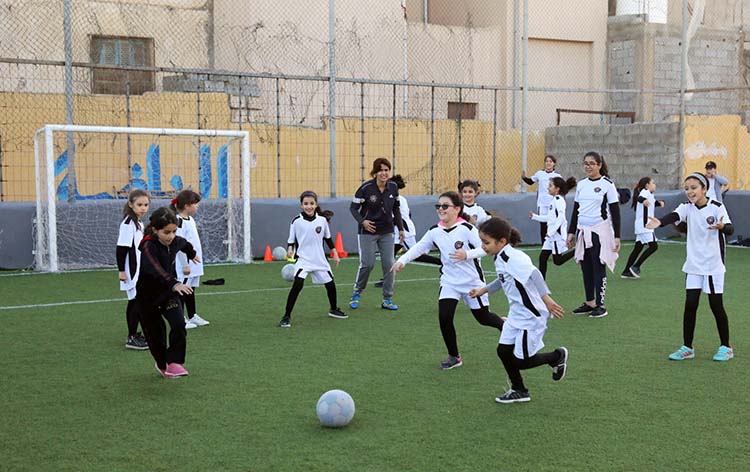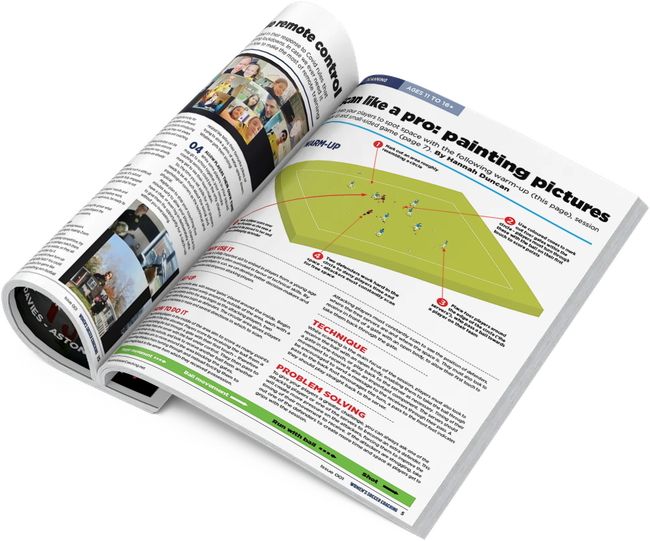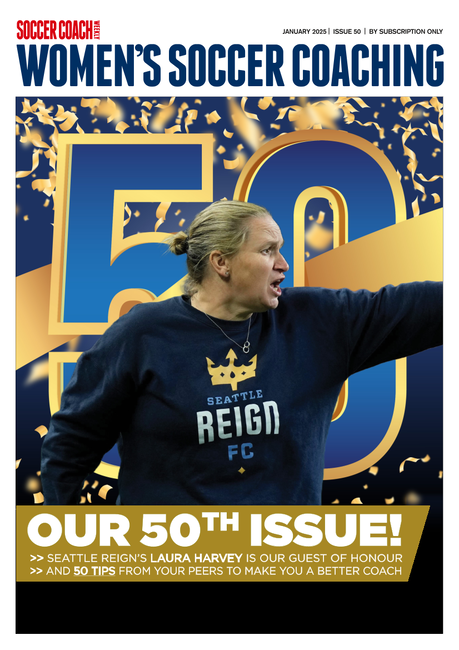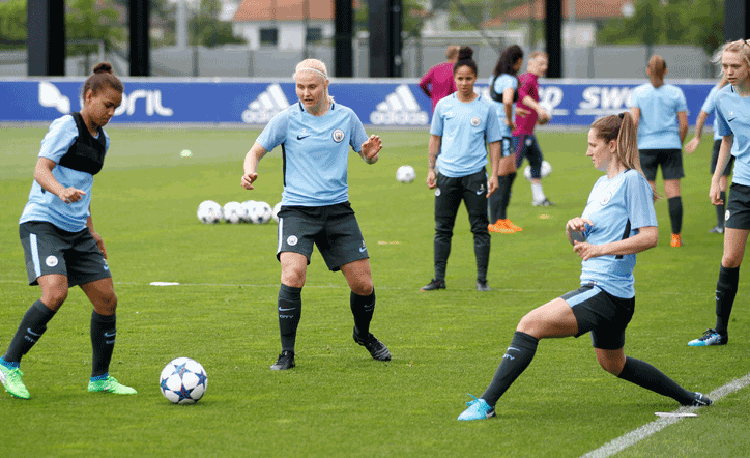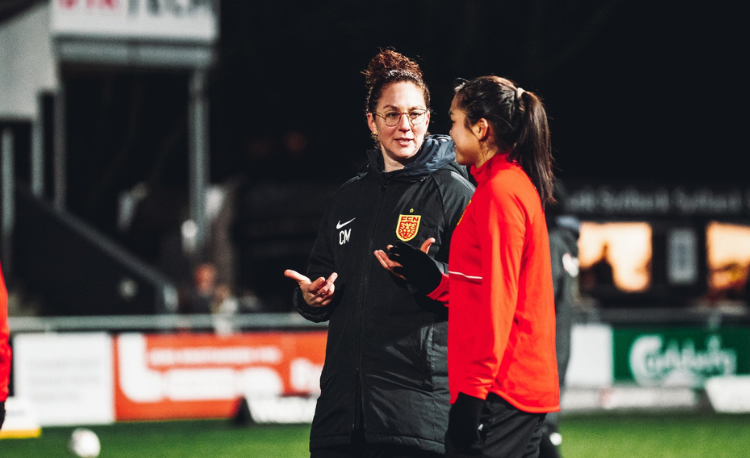You are viewing
1 of your 3 free articles
Midfielders feed attackers
Coaching Adviceby Carl Wild
Sessions do not have to look pretty to get results - in fact, planning for organised mess produces more realistic situations, argues Carl Wild
It can be difficult to just stand back and watch when a practice is not going how we envisaged.
As coaches, we can be highly self-critical and want everything to be perfect. We therefore put added pressure on ourselves when we feel something is not working - moreso when it is front of parents or other coaches.
As a result, we can focus all our attention on ensuring players are performing how we want them to and making sure the practice looks aesthetically pleasing. Quite often we mistake this ‘correction’ for player development, when in fact we have either stopped the learning process in its tracks or prevented it from even beginning.
When working with young children in particular, we need to be brave as coaches and ‘embrace chaos’, which can often provide the perfect environment for player development.
Where there is chaos, you will usually find a number of factors that are seen as being essential within player development, such as problem solving, creativity and decision making. By making a practice too structured, particularly when working with really young players, we can take away the opportunity for the players to develop these key aspects of the game.
We must be brave and comfortable with our practices looking ‘messy’ and be able to look through what might look like chaos and see the learning that is taking place.
This can be particularly important when working with young female players, as they are less likely to engage in this type of play outside of the training environment and, therefore, may not have as many opportunities as boys to be able to experience this kind of chaos.
To do this, practices should contain some of the key ingredients needed to produce chaos; freedom, traffic, multiple directions, and constant involvement. An example of how this can be achieved is on page 15.
At first glance, this practice will look messy and chaotic, in that players will come and go as they please between different sections, some areas of the practice will be busier than others and there will be very little structure.
However, what is actually happening, is that the players are being exposed to a wide range of experiences that are linked to the focus of the session, within a fun and competitive environment.
Because the players are all being allowed to decide which area to enter, when and how, they will frequently come across other players, either those with a ball or those whose role it is to take the ball off them.
Therefore, they will have to constantly manipulate the ball, change the direction in which they are going and alter the speed they are travelling at, all while scanning and looking for space to move into.
Basically, the chaos is providing the players with similar situations they will find in the game of football, allowing them to practice relevant skills in a realistic environment.
As a result, we can focus all our attention on ensuring players are performing how we want them to and making sure the practice looks aesthetically pleasing. Quite often we mistake this ‘correction’ for player development, when in fact we have either stopped the learning process in its tracks or prevented it from even beginning.
When working with young children in particular, we need to be brave as coaches and ‘embrace chaos’, which can often provide the perfect environment for player development.
Where there is chaos, you will usually find a number of factors that are seen as being essential within player development, such as problem solving, creativity and decision making. By making a practice too structured, particularly when working with really young players, we can take away the opportunity for the players to develop these key aspects of the game.
We must be brave and comfortable with our practices looking ‘messy’ and be able to look through what might look like chaos and see the learning that is taking place.
This can be particularly important when working with young female players, as they are less likely to engage in this type of play outside of the training environment and, therefore, may not have as many opportunities as boys to be able to experience this kind of chaos.
“Chaos provides players with similar situations they will find in a game...”The most effective way in which we can embrace chaos and use it in the development of players is to actually plan for it, so that it becomes ‘organised chaos’.
To do this, practices should contain some of the key ingredients needed to produce chaos; freedom, traffic, multiple directions, and constant involvement. An example of how this can be achieved is on page 15.
At first glance, this practice will look messy and chaotic, in that players will come and go as they please between different sections, some areas of the practice will be busier than others and there will be very little structure.
However, what is actually happening, is that the players are being exposed to a wide range of experiences that are linked to the focus of the session, within a fun and competitive environment.
Because the players are all being allowed to decide which area to enter, when and how, they will frequently come across other players, either those with a ball or those whose role it is to take the ball off them.
Therefore, they will have to constantly manipulate the ball, change the direction in which they are going and alter the speed they are travelling at, all while scanning and looking for space to move into.
Basically, the chaos is providing the players with similar situations they will find in the game of football, allowing them to practice relevant skills in a realistic environment.
Related Files
WSC-008-embracing-chaos.pdfPDF, 2.1 MB
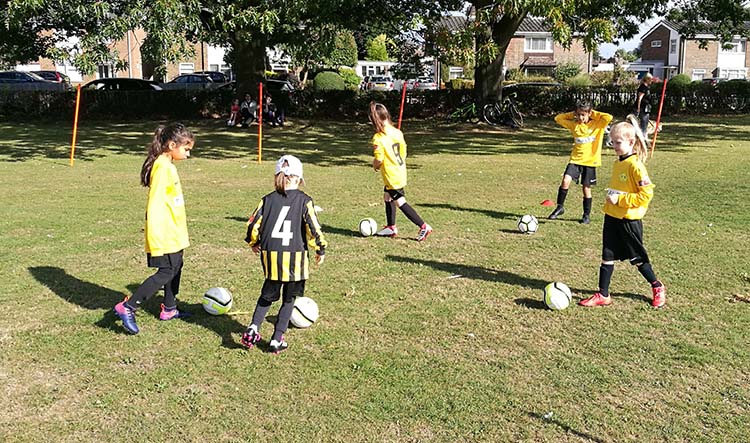
When working with the youngest players, coaches need to be brave to embrace the chaos, says Carl Wild, as it provides a perfect environment for development
As well as producing an unpredictable environment that provides constant opportunities for learning to take place, this particular form of planned chaos also allows for differentiation.
By letting players make their own decisions, specifically which areas they visit, it gives them the opportunity to select the level of challenge they will face.
For instance, if they want less of a challenge, they could enter an area with just one defender or an area where there are lots of other players, who are already occupying the defenders.
Essentially the chaos presents the players with different options, which in turn, allows them to make decisions. This then further increases both the level and amount of learning that is happening within the practice.
As adults, we like organisation and structure, but during our childhood we much preferred random and mess - we enjoyed things to be unpredictable, very much like the game of football itself.
When we consider the smaller versions of the game in particular - five versus five, seven versus seven, the formats that young players play - these are really chaotic with the players chasing the ball and having little understanding of the tactical side of the game.
Similarly, if we were to watch children play in the school yard, the games are quite often chaotic with rules that are regularly reviewed and adjusted.
Children do not want to be confined. They want the freedom to be creative and imaginative and the chance to express themselves. We therefore need to take full advantage of this and place them in practices where there are few restrictions and they are allowed to explore and experiment.
We need to remove the necessity for the coach to have full control of what the players are doing and the need for faultless-looking sessions.
We need to be able to trust the players and have the belief in them that they can cope with everything that these types of practices throw at them.
In these instances, we can let the environment be the main source of learning, with our role being to provide guidance and support through encouragement, individual challenges and effective questioning.
Therefore, instead of trying to prevent chaos within our practices, we should look to incorporate it and actually use it, as part of our long-term player development strategy. EMBRACE CHAOS PRACTICE
Now use the Embracing chaos practice activity to harness chaos and give your players decisions to make...
By letting players make their own decisions, specifically which areas they visit, it gives them the opportunity to select the level of challenge they will face.
For instance, if they want less of a challenge, they could enter an area with just one defender or an area where there are lots of other players, who are already occupying the defenders.
Essentially the chaos presents the players with different options, which in turn, allows them to make decisions. This then further increases both the level and amount of learning that is happening within the practice.
As adults, we like organisation and structure, but during our childhood we much preferred random and mess - we enjoyed things to be unpredictable, very much like the game of football itself.
When we consider the smaller versions of the game in particular - five versus five, seven versus seven, the formats that young players play - these are really chaotic with the players chasing the ball and having little understanding of the tactical side of the game.
Similarly, if we were to watch children play in the school yard, the games are quite often chaotic with rules that are regularly reviewed and adjusted.
Children do not want to be confined. They want the freedom to be creative and imaginative and the chance to express themselves. We therefore need to take full advantage of this and place them in practices where there are few restrictions and they are allowed to explore and experiment.
We need to remove the necessity for the coach to have full control of what the players are doing and the need for faultless-looking sessions.
“Adults like structure but during childhood we much preferred random and mess...”Instead, we should be looking to plan practices that first of all give the players the opportunity to do what they enjoy and, secondly, provides them with an environment that helps support and accelerate their development.
We need to be able to trust the players and have the belief in them that they can cope with everything that these types of practices throw at them.
In these instances, we can let the environment be the main source of learning, with our role being to provide guidance and support through encouragement, individual challenges and effective questioning.
Therefore, instead of trying to prevent chaos within our practices, we should look to incorporate it and actually use it, as part of our long-term player development strategy. EMBRACE CHAOS PRACTICE
Now use the Embracing chaos practice activity to harness chaos and give your players decisions to make...
4. The midfielder is played in with a pass from the team on the counter attack
Newsletter Sign Up
Newsletter Sign Up
Discover the simple way to become a more effective, more successful soccer coach
In a recent survey 89% of subscribers said Women's Soccer Coaching makes them more confident, 91% said Women's Soccer Coaching makes them a more effective coach and 93% said Women's Soccer Coaching makes them more inspired.
*includes 3 coaching manuals
Get Inspired
All the latest techniques and approaches
Women's Soccer Coaching offers proven and easy to use soccer drills, coaching sessions, practice plans, small-sided games, warm-ups, training tips and advice.
We've been at the cutting edge of soccer coaching since we launched Soccer Coach Weekly in 2007, creating resources for the grassroots youth coach, following best practice from around the world and insights from the professional game.
